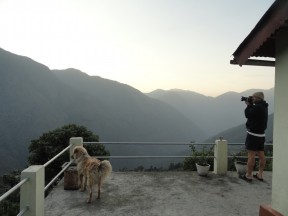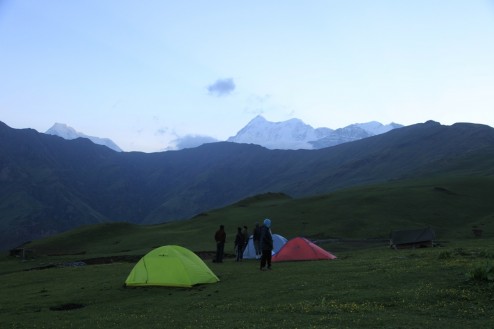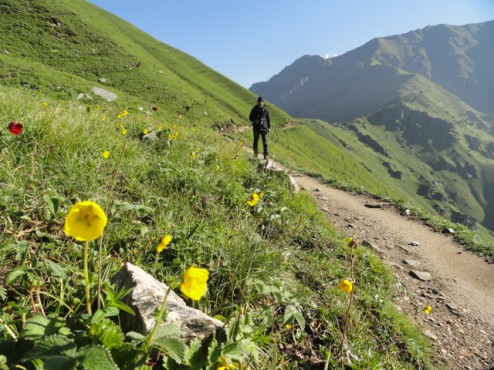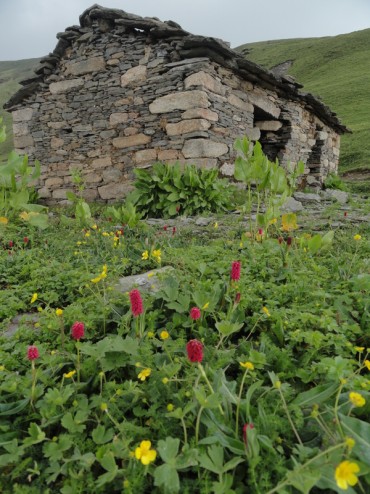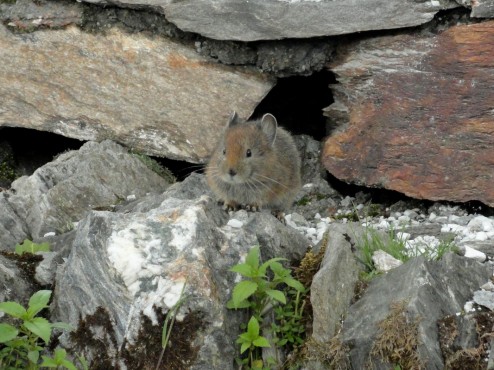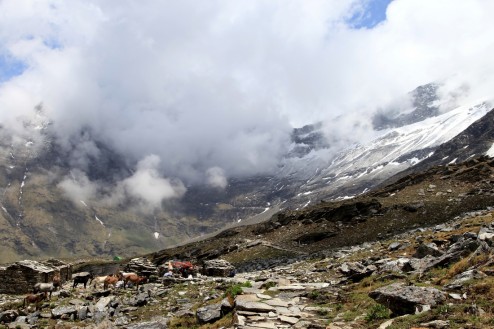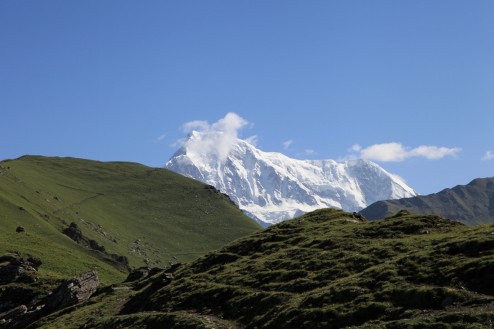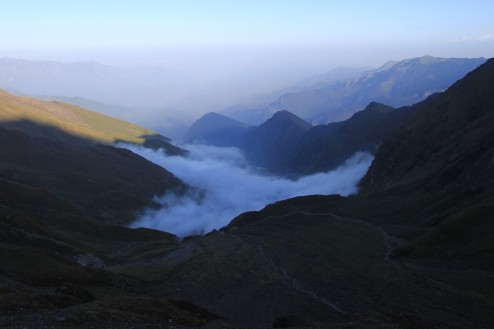They say that if you make the mistake of venturing into the Himalayas even once you are doomed. Because they keep calling you back. Neither pictures, nor words can capture the magnificence of those mesmerising bugyals and towering peaks whose beauty brought tears to my eyes. Hope some of you will read this travelogue and feel the urge to see them for yourself, because only then will you understand what I want to say.
**
Day 1 – Drive to Lohajung. Height: 8,000 feet
5 pm. It’s getting dark and rain clouds are gearing up overhead. We have been cramped up in the car for 10 hours. The oily samosa I had in Karnprayag, the last big town nestling lazily in the folds of the flowing Alakhnanda more than two hours back, is swirling in the depths of my stomach and I swallow another pill to keep nausea at bay. Now we are on a lonely mud track with forest cover all around. What’s worse, there is no cell phone coverage and not a soul to ask if we are going the right way. I feel sick, sweaty and worried as hell. We haven’t been able to use the car AC either since dad’s Alto refuses to climb uphill with it on. It starts to rain and when husband turns to me and says: “hope we are on the right track”, I lose it completely.
**
Suddenly, the cell phone rings from the dead. It’s our guide Mohan, wondering why we haven’t reached Lohajung yet. We have an hour more to go. I just grit my teeth and sit in sullen silence, staring out of the window with rain splashing my face. A few more turns on the road and the air gets cooler. Eventually we are in Lohajung market (a sprinkle of about a dozen odd shops) where Heera Singh Bisht, Mohan’s second in command, is waiting for us. He directs us to retired Sub Major Dayal Singh Patwal’s lodge – a quaint hill house with an apple tree drooping over the stone steps. To my dismay I find that the toilets are set away from the rooms. But they are clean and Patwalji’s daughter Geeta has carried half a bucket of hot water (heated on firewood) for me to the bathroom. After a bath and a hot meal with the large and furry dog Brownie (pronounced Brawny) nibbling crumbs at my feet, I return to the room, pointedly turn my back to husband and go to sleep.
**
**
Day2 Wan to Bedini bugyal. Distance covered: 15 km. Height: 11,000 feet
5 am. I wake up, throw the fat cotton rajai off and open the creaking wooden door of the room. Outside lie strewn dead bodies of strange bugs and giant mosquitoes that have committed suicide sometime in the night by dashing against the yellow light bulb. I look up and nearly forget to breathe. Right across, a snow covered peak towers above mountain ranges that are so high that they are blocking the sun that hasn’t risen high enough yet. Shafts of sunlight are sifting through the clefts in the mountain and translucent white rays are spilling over the forests and villages on the hillside. It’s the large and intimidating Nanda Ghunti laughing at my misconceptions about the importance of my puny existence.
**
Shamed, I walk across to the green apple laden trees, check out the pretty pink roses rising from a broken tin can and climbing up a stone wall, and feed Brawny the toffees lying in my pocket. He swallows them happily and becomes my loyal subject. We walk across to the kitchen to find Geeta chopping some fresh green spring onion, ask her for “dwui gilas chai, chinni kam” and wake up husband to the view outside. The two of us sit there wordlessly soaking in the splendor of the Himalayas while Brawnie (who sees it everyday) yawns and goes back to sleep.
**
6 am. We tuck into big rotis and pyaaz ki sabzi made in mustard oil (that sentimentally reminds husband of his mom’s cooking), say bye to Patwalji and his family and get into the jeep that Balwant Singh (yet another) Bisht is cheerfully driving. The rickety old jeep crosses some pretty fields, villages and women out to get firewood, all of who are on first name terms with Ballu and finally rumbles to a stop where a slim built man with a sunburnt face and very white teeth is grinning at us widely. It’s Mohan Singh Bisht, our guide saab for the trek. When he finds out I’m a Bisht too, he insists on calling me didiji and husband – Rawatji, giving him the exalted status of jawaiji (son in law). It gets Manoj some VIP treatment throughout the trek which shall include having tea and soup served in the tent and piping hot rotis at mealtimes while the rest of us are fed rice andpeeli dal.
**
My most endearing memory of Wan is of the one-roomed Aanganwadi school I peep into by mistake. A little boy with apple pink cheeks is perched on a chair twice his size. He is reading a lesson that his four students – as cute as him – are repeating after him in sing song voices. “A for appil, appil maane seb; B for bwaay, bwaay maane ladka..” When he stops for breath at “H for hauj, hauj maane ghar” I ask him where the teacher is. “Madamji, bazaar jayin chin” he tells me curtly in Garhwali and gets on with the lesson. Their shrill voices ring out in my ear as I step out to find a bwaadi in a pahadi sari and guluband just like my long-departed grandmother used to wear (now my most prized piece of jewellery) with almost as many wrinkles looping across her attractive face. When I tell her that, she gives me a hug and gets on with spreading wheat out to dry on an open roof.
**
10 am. Climbing up to the old temple near the guest house, we cross small terrace fields cut into the slope, kids with runny noses and houses where women are threshing wheat. Little kids stop and say namaste asking for “mithai” (toffees). We step across a shallow stream and find some prettyghaseries fetching leaves in large cane baskets. I try picking one up and my back bends under its weight. The strain of the climb has started to show. Each time I stretch and fold my leg I can hear a creaking sound in my knee, as if it needs oiling.
**
We have been walking for four hours through dense Alpine forests with twisted gnarled roots that look like tortured souls in hell. As I lower myself onto the grass and deep breathe to slow down the heart beat, wishing I never had to get up again, I spot a flash of red. It is 62-year-old fellow trekker Narayan Chaudhari from Mumbai moving ahead with a winning smile. Gritting my teeth, I get up. In husband’s eyes I can see that he is dying to catch up with this Amitabh Bachchan of trekkers and show him what strong stuff Army officers are made of but husbandly responsibilities restrict his aspirations. He hands me my walking stick and says: “start walking or your body will get cold”. For once I follow obediently.
**
It has rained off and on through the night (more on than off). The end of my sleeping bag feels colder than usual and it takes me a while to realize that some rain water has seeped in. Luckily it is at the foot end and by moving my head right up and not stretching my legs all the way down I manage to avoid the wetness. That’s the only time I have felt happy about being short. I can’t get to sleep though and ask husband if he’s up as well. He is. It’s 2 am and we just lie in the dark till I hear him snoring. I want to walk down to the toilet tent but the fear of an encounter with a bear or leopard is a big deterrent. I distract myself by going carefully over all the calamities that can kill us right there in the cold, dark night (earthquake/wild animal/landslide) . Drifting in and out of these pleasant thoughts I finally wake up to the chatter of the boys preparing tea, which means it is 4 am. Mist has dropped around us and a shadowy figure is handing out steaming chai in steel glasses.
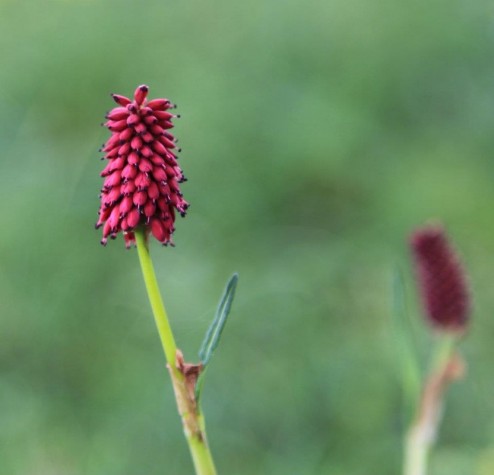 **
**The climb is tough and there are slippery patches of ice where footholds are hard to find but in two hours plus we manage to reach the summit. Surrounded by snow covered slopes, Roopkund lake stretches before us in a pale blue circle of frozen ice. A pile of bones and a cracked skull lie in a corner. Old man Bakhtyar Singh (Mohan’s dad) points out landslides that he says have covered the rest of the skeletons and some, he says, lie buried inside the lake. According to National Geographic more than 500 travellers were caught there in a hail storm hundreds of years back. He blows a conch at the temple and tells us how the route we took was the same as that the gods Shiv and Parvati took on their way to Kailash. At this point, he says, Parvatiji felt thirsty. Shivji created a lake in the mountain. When Parvati was bending down to drink from it, she saw her reflection in the water and realized how beautiful she was and what a tramp she had married. That didn’t deter her though and she followed him all the way to Mount Kailash. The lake was named Roopkund. Manoj climbs halfway to Junargali pass to see the mighty Kailash, that lies on the other side and finally after some biscuits and a photo shoot we set back for Pathar Nachuni where the two trekkers who dropped out wait for us.
**
The next day we will walk back 21 kms to reach Wan and after a night halt with Patwalji (who will make husband (and not me – scowl) the kindly offer: “ek drinks le lijiye Sir, thak gaye honge”) start back on the long ride home. One day soon we know we will have to come back. Because, like I told you before, once you visit the Himalayas you are destined to return. They have started calling me back in my dreams already.







